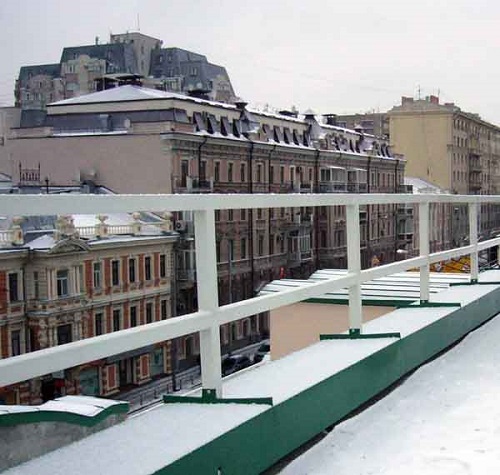
It is no secret that in the winter season, snow that settles on the roofs, under certain circumstances, can fall down and cause harm to people and their property. In order to prevent avalanche-like falling of snow, as well as protection against injuries of people working on the roof, a roof fencing is arranged.
For uniform convergence of snow layers from the roof, snow guard is installed on it. Then the roof rails pass special tests. They allow us to conclude about the state of the roof and its ability to ensure the safe operation of people on it.

In European countries, when commissioning an object, a technical test of the building envelope is mandatory. Its absence does not qualify for insurance of such property.
The technology of building production makes its demands on the construction of building envelopes. Therefore, when designing the roof fencing, SNiP should be taken into account and considered as the basis for the quality of installation work. They must be made before the roof is finished.
Content
Features of roofing fences
The roof, like other elements of the building, requires periodic inspection, maintenance and repair. To carry out such work, it is necessary to ensure the safety of people. For this reason, it is necessary to carry out work on the installation of fences on the roof in the process of building construction.
Building standards and GOST roof fencing, oblige to install it when the height of the buildings exceeds 10 meters, and the roof slope is not more than 12? . Do this also when the height of the house is more than 7 meters, in the slope of the roof - more than 12 ?. It is also necessary under any conditions to erect such a fence on
- flat exploited roofs;
- loggias and balconies;
- outdoor galleries;
- stairs and outdoor areas.
It's no secret that buildings differ one from one not only by facades, but also by the type of roofs or, rather, their design. According to the type of construction, roofs are flat and pitched.
Depending on the roof structure, the number and location of slopes, pitched roofs can be single, double or four-pitched. Roofs of this type have cottages, country houses and cottages.
The roofs of the attic type have a rather steep slope. In this regard, to make roof fencing on it, as a rule, is impossible.
Multi-gable roofs have several slopes that are arranged in a complex order relative to each other. Making fencing on them is also quite difficult.
For a number of reasons, standard flat roofs are especially popular these days. Moreover, they are used not only in multi-storey construction, but also in the construction of suburban cottages, houses and office buildings. Thanks to this design, you can have an additional roof area for walking in the fresh air, relaxing, etc. Such a roof can be considered a kind of balcony and therefore the height of the roof fencing, in this case, plays not only a protective, but also an aesthetic role.
Regardless of the design, all types of roofs are divided into two types - operated and non-operated. It makes no difference whether they are pitched or flat.
Maintenance Roof Fencing
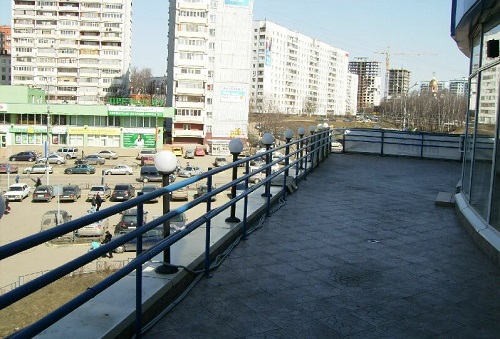
The operated roof has a structure that allows people to go out on the roof and carry out various works there - install equipment, remove snow, etc. All this implies that for reliable protection of people it must have a strong and reliable roof guard. According to its requirements, it is identical to a balcony railing, namely:
- When the building has a height of less than 30 m, the minimum height of the fence should be 110 cm, and with a height of more than 30 m - 120 cm.
- When installing the parapet fence, the height of the fence itself decreases by the height of the parapet.
- The vertical and horizontal elements of the fence should be located at a certain distance from each other. Vertical - no more than 10 cm, horizontal - no more than 30 cm.
- Roof fences, in addition to a steel lattice frame, can be equipped (according to GOST) with a hinged screen, which is made of special glass.
Roofs in operation are distinguished by the fact that they are equipped with a rigid base, on which material is subsequently laid for the final roof covering. Due to this reason, people are given the opportunity to often appear on the roof and perform various tasks - to repair the roof itself, install the necessary equipment and periodically clear snow. Roofing fences at this time serve as their protection.
Regulates the requirements for the installation of roof fencing GOST 25772-83 "Steel staircases, balconies and roof fencing".
Roof fencing
Although the unexploited roofing is not designed for people to appear on it, it still needs periodic repairs and constant maintenance. Roof fences, in this case, ensure the safety of those involved in such works. Its height should be at least 60 cm and does not depend on the height of the building and the number of floors.
The horizontal elements of such a roofing fence should not be located at a distance of more than 30 centimeters.
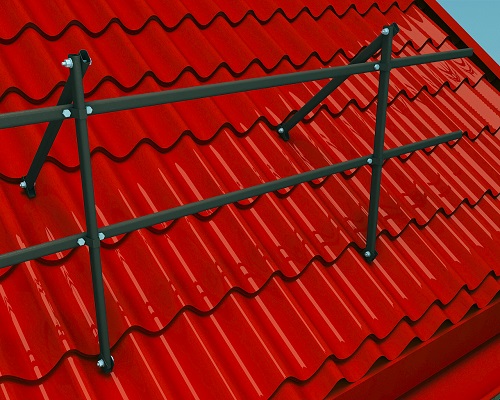
Since the movement of people on the surface of an unexploited roof is not provided, there is no need to install a rigid base under the roofing. But, as life shows, unforeseen situations can arise when the appearance of a person on the roof becomes simply necessary. For such cases, a special roof guard is provided. These can be walkways or special gangways, the purpose of which is to minimize the risk of a person falling from the roof. They help to evenly distribute the weight load from the presence of people on the entire surface of the roofing.
The requirements of SNiP also apply to this type of roof, but the technical parameters presented by GOST are slightly different:
- Roof fences in height have a minimum value of 60 centimeters. It is not directly dependent on either the height of the building or its number of storeys.
- The distance that is provided between the balusters and the crossbars, which are separate elements of the fence, is not more than 30 cm.
To ensure safety during operation and repair work on pitched roofs, they install additional elements - snow retainers, roof ladders, bridges, as well as roof fencing.
Roof fences - what materials?

Modern technologies used in the manufacture of fencing for roofs make it possible to produce individual elements and structures from metal, which is powder coated. Such modern protection allows you to make the roof fencing more stable in relation to the negative effects of the environment. At the same time, its aesthetic qualities are improved, and it becomes an attractive element of the constructed structure.
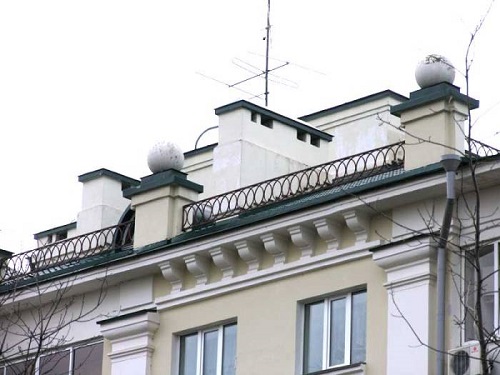
Among the most effective materials that are used in the manufacture of fences, stainless steel is considered. It is highly durable and has an attractive appearance. The use of special glass, which is combined with metal, can significantly expand the capabilities of designers and artists creating individual roofing fencing. They should be not only reliable, but also outwardly attractive, harmoniously fit into the general ensemble of the structure and not attract too much attention.
Such designs are reliable because they are made of metal, which is coated with a special decorative and protective layer. Powder spraying can significantly increase the life of the building envelope. The roofing fence "Metalprofile" for today is considered the most modern and attractive.
In addition to the reliability and attractiveness of the fence, it must fulfill its direct function - to be responsible for the safety of people. If you comply with the installation technology and the application of the norms and requirements of regulatory documents, you can be completely sure of their protective function.
Where fastening to the base of the roof takes place, the roof guard should be protected from corrosion with a special sealant. Special plugs will protect the adjacent roof sections.
To increase the safety of people, in addition to fences on the roof, transitional bridges are installed to help reduce the weight and size of the snow layer during the winter season.

If you decide to carry out preventive or repair work on the roof, on which there is no fence, then you risk your health and life! Properly selecting the materials and correctly performing the roof fencing, you will reduce to zero the risk of falling during such work.
One of the options for roof fencing
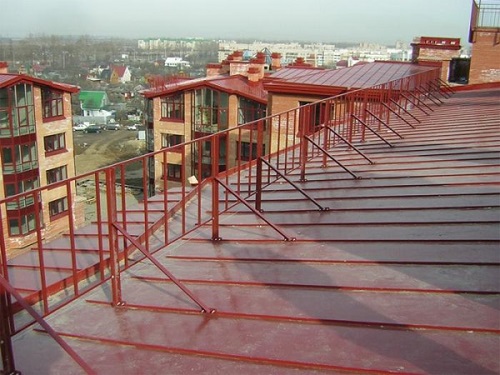
Such a design as roofing fencing is quite simple and is carried out according to generally accepted standards. It consists of vertical supports and two horizontal rungs that are rigidly fastened together. As a support, a steel corner is used, which at the bottom is bent in the form of a triangle. The horizontal component of this triangle is attached to the roof surface, the vertical is designed to accept the functional load, and the diagonal - to provide additional structural rigidity.
By arranging the roof guard, the support is aligned with the plane of the roof slope and fixed with bolts. After that, it is fixed on a bar in the lower part of the roofing sheet using 3 galvanized self-tapping screws, which are equipped with special rubber gaskets.

Note! Roof fencing should be performed with the following parameters: the height of the supports is up to 70 cm, the distance between the supports and the cornice edge is at least 35 cm, the distance between the adjacent supports is 90-120 cm.
The material for horizontal rungs are steel pipes 3 meters long. They are installed in special holes of the supports where the crossbars are fixed using self-tapping screws with a drill. The other end of the pipe is closed with a plug.
Roof fences can be made of stainless and galvanized steel, copper, aluminum and other materials. If necessary, they can be painted in any color that is most combined with the color of the roof topcoat.

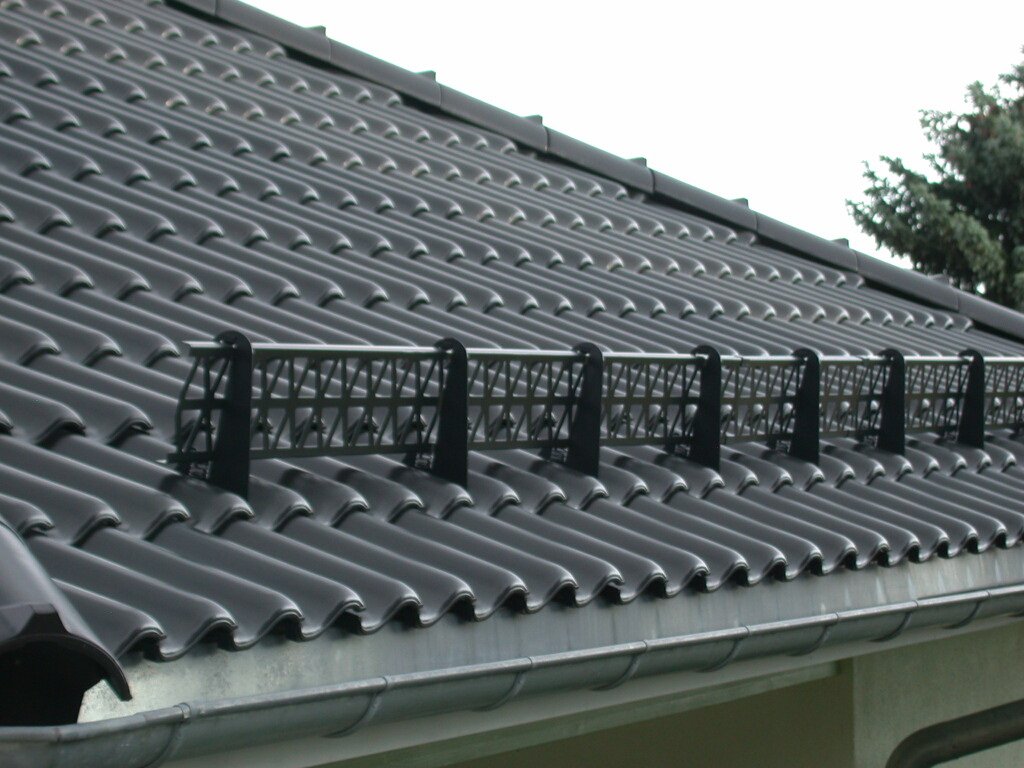



Alas, no comments yet. Be the first!